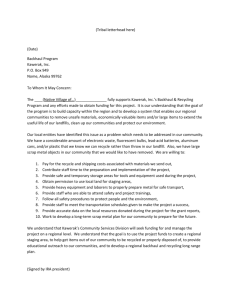Scrap metal - Clean Up Australia
advertisement
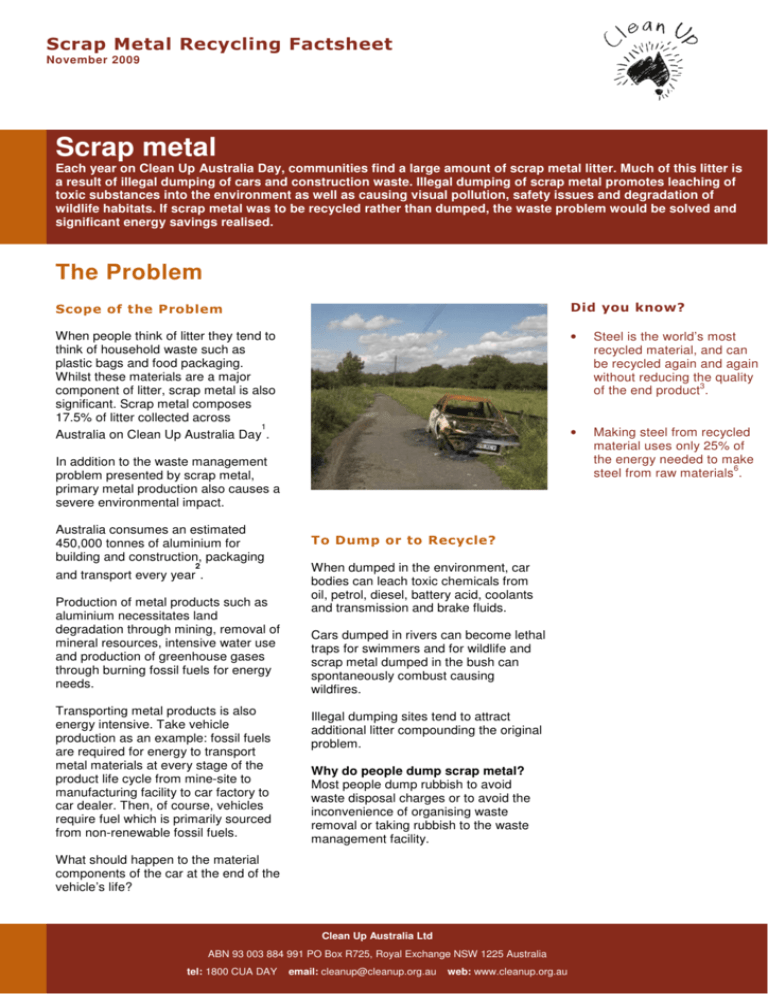
Scrap Metal Recycling Factsheet November 2009 Scrap metal Each year on Clean Up Australia Day, communities find a large amount of scrap metal litter. Much of this litter is a result of illegal dumping of cars and construction waste. Illegal dumping of scrap metal promotes leaching of toxic substances into the environment as well as causing visual pollution, safety issues and degradation of wildlife habitats. If scrap metal was to be recycled rather than dumped, the waste problem would be solved and significant energy savings realised. The Problem Scope of the Problem Did you know? When people think of litter they tend to think of household waste such as plastic bags and food packaging. Whilst these materials are a major component of litter, scrap metal is also significant. Scrap metal composes 17.5% of litter collected across 1 Australia on Clean Up Australia Day . • Steel is the world’s most recycled material, and can be recycled again and again without reducing the quality 3 of the end product . • Making steel from recycled material uses only 25% of the energy needed to make 6 steel from raw materials . In addition to the waste management problem presented by scrap metal, primary metal production also causes a severe environmental impact. Australia consumes an estimated 450,000 tonnes of aluminium for building and construction, packaging 2 and transport every year . Production of metal products such as aluminium necessitates land degradation through mining, removal of mineral resources, intensive water use and production of greenhouse gases through burning fossil fuels for energy needs. Transporting metal products is also energy intensive. Take vehicle production as an example: fossil fuels are required for energy to transport metal materials at every stage of the product life cycle from mine-site to manufacturing facility to car factory to car dealer. Then, of course, vehicles require fuel which is primarily sourced from non-renewable fossil fuels. To Dump or to Recycle? When dumped in the environment, car bodies can leach toxic chemicals from oil, petrol, diesel, battery acid, coolants and transmission and brake fluids. Cars dumped in rivers can become lethal traps for swimmers and for wildlife and scrap metal dumped in the bush can spontaneously combust causing wildfires. Illegal dumping sites tend to attract additional litter compounding the original problem. Why do people dump scrap metal? Most people dump rubbish to avoid waste disposal charges or to avoid the inconvenience of organising waste removal or taking rubbish to the waste management facility. What should happen to the material components of the car at the end of the vehicle’s life? Clean Up Australia Ltd ABN 93 003 884 991 PO Box R725, Royal Exchange NSW 1225 Australia tel: 1800 CUA DAY email: cleanup@cleanup.org.au Clean Up Australia Limited ABN 93 003 884 991 web: www.cleanup.org.au Scrap Metal Recycling Factsheet November 2009 Benefits of Recycling Scrap Metal The Solution Why should we recycle scrap metal? How to Recycle Scrap Metal References Recycling scrap metal means that we avoid the environmental costs of dumped rubbish and the risk of it leaching toxic chemicals into groundwater at landfill sites. Scrap metal can be recycled at local council refuse stations, through on site pick ups or at scrap metal merchants. 1 Clean Up Australia Ltd Rubbish Report 2009 In addition, we avoid the cost of taking rubbish to the waste management facility. Further information can be found at PlanetArk’s Recycling Near You website: www.recyclingnearyou.com.au Benefits of Recycling Scrap Metal Closing the Loop Closing the loop is about looking after a product throughout its entire life cycle. When we successfully close the loop we create zero waste because all materials are recycled or reused. Metals lend themselves to recycling and reuse because they have a virtually unlimited lifespan. Aluminium and steel products can be sorted from other products for recycling by magnetic means: this is far easier than manual sorting. Every tonne of recycled steel saves 1131kg of iron ore, 633kg of coal and 5 54 kg of limestone . The Recycling Process In Australian capital cities scrap metal is collected by businesses and local government, broken down with larger shredders, sorted by type and melted down to become a renewable resource equal in standard to the original product. Sustainability Benefits of Closing the Loop Conserve valuable natural resources and raw materials Avoid air and water pollution: using recycled materials generally creates less pollution Save landfill space by closing the loop. Recycling also ensures materials don’t become litter! Reducing the need to dig for virgin materials conserves soil integrity and wildlife habitats Save energy: recycled products require less energy to manufacture thus conserving oil and reducing greenhouse gas emissions Reduces costs of sourcing raw materials: these savings should be passed on to the consumer in reduced prices. Consumers can receive a return on the original capital outlay when they return used products to producers. Scrap Metal in our Environment None of us like stumbling upon dumped scrap metal when we go for a bushwalk or stroll around our neighbourhoods. All Australians can play a part in reporting illegal dumping and recycling scrap metal. Clean Up Australia Ltd ABN 93 003 884 991 PO Box R725, Royal Exchange NSW 1225 Australia tel: 1800 CUA DAY email: cleanup@cleanup.org.au Clean Up Australia Limited ABN 93 003 884 991 web: www.cleanup.org.au 2 Australian Aluminium Council http://www.aluminium.org.au/Page. php?s=1005 3 Canadian Sheet Steel Building Institute Sheet Steel Factsheet 20 http://www.cssbi.ca/Eng/_pdf/Facts 20.pdf 4 International Aluminium Institute www.world-aluminium.org 5 CanSmart http://www.cansmart.org/Facts/fast _facts.html
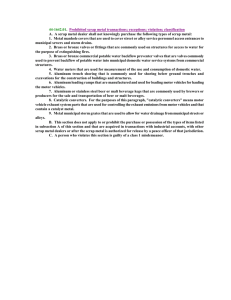
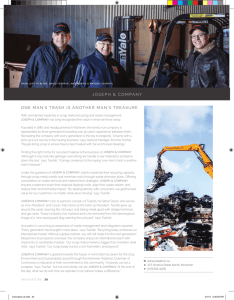
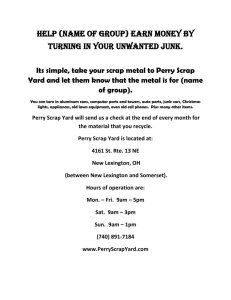
![You`re invited to celebrate [child`s name]`s birthday at SCRAP! What](http://s3.studylib.net/store/data/007177272_1-c15601fb9e11b26854f13f1982e634e8-300x300.png)
